 GENERAL AUDIENCE TODAY
GENERAL AUDIENCE TODAY
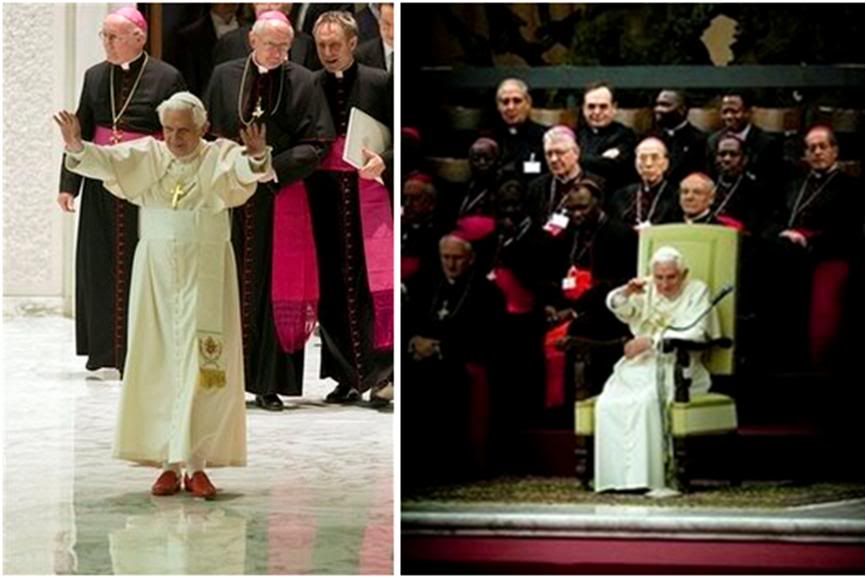 Different onstage configuration today: attending prelates grouped around the Pope rather than seated off to the sides. Judging by the number of cardinals present, the group could be the plenary membership of the Congregation for the Evangelization of Peoples meeting this week in Rome.
Different onstage configuration today: attending prelates grouped around the Pope rather than seated off to the sides. Judging by the number of cardinals present, the group could be the plenary membership of the Congregation for the Evangelization of Peoples meeting this week in Rome.
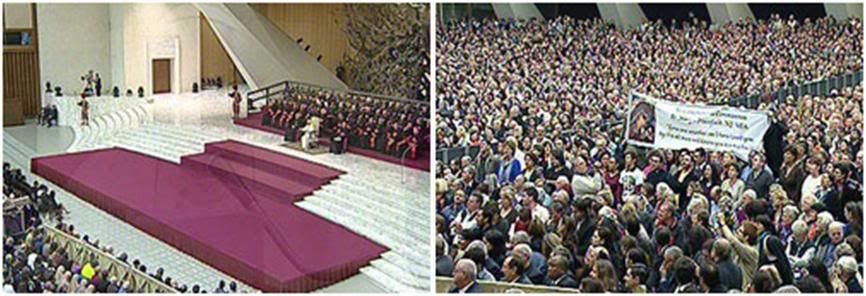
The Holy Father himself introduces today's catechesis best with his synthesis in English:
I have been speaking in recent weeks about medieval theology, and would now like to turn my attention to how the Christian faith of the Middle Ages inspired some of the greatest works of art of all time: the cathedrals of Europe.
Romanesque cathedrals are distinctive for their size and for introducing to churches beautiful sculpture, including the image of Christ as the Universal Judge and the Gate of Heaven.
By entering through Him, as it were, the faithful enter a space and even a time different from everyday life, somewhere they can anticipate eternal life through their participation in the liturgy.
Gradually, Gothic architecture replaced the Romanesque, adding height and luminosity to the previous style. The Gothic cathedral translates the aspirations of the soul into architectural lines, and is a synthesis between faith, art and beauty which still raises our hearts and minds to God today.
When faith encounters art, in particular in the liturgy, a profound synthesis is created, making visible the Invisible, and the two great architectural styles of the Middle Ages demonstrate how beauty is a powerful means to draw us closer to the Mystery of God.
May the Lord help us to rediscover that "way of beauty", surely one of the best ways to know and to love Almighty God.
Appeal for the children of the world
At the end of his plurilingual greetings today, the Holy Father made a special appeal in behalf of the children of the world:
Day after tomorrow, the United Nations will observe the World Day of Prayer and Action for Children, on the 20th anniversary of the adoption of the Convention on the Rights of the Child.
My thoughts go to all the children of the world, especially those who live in difficult conditions and suffer because of violence, abuses, sickness, war or hunger.
I invite you to join my prayers, and at the same time, I appeal to the international community so that it may multiply efforts for an adequate response to the tragic problems of children.
May there be no lack of generous commitment by everyone so that the rights of children may be recognized and that they may be respected more than ever in their dignity.
The Convention on the Rights of the Child is the first international law on children, In its 54 articles, it recognizes that all human beings under 18 are individuals with a right to full physical, mental and social development, as well as the right to express their opinions freely.
UNICEF says that in spelling out the rights of children and minors, the convention also sets standards for the health, survival and progress of every human society; and that its acceptance by almost all the nations of the world has reinforced the acknowledgment of fundamental human dignity in all persons of whatever age in order to guarantee the protection and development of the young.
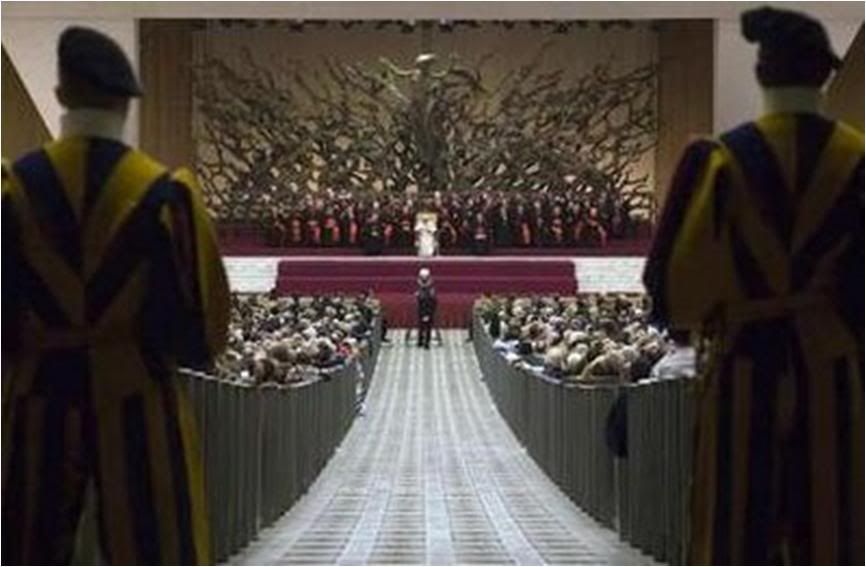
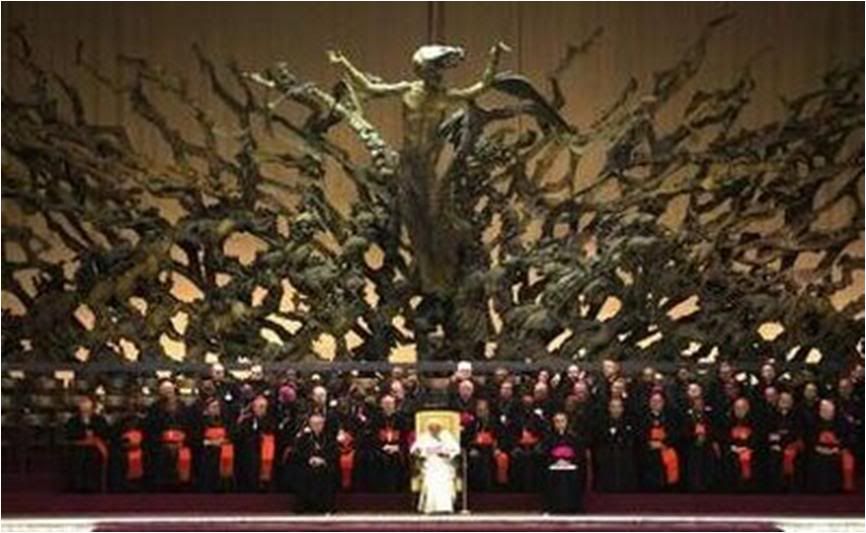
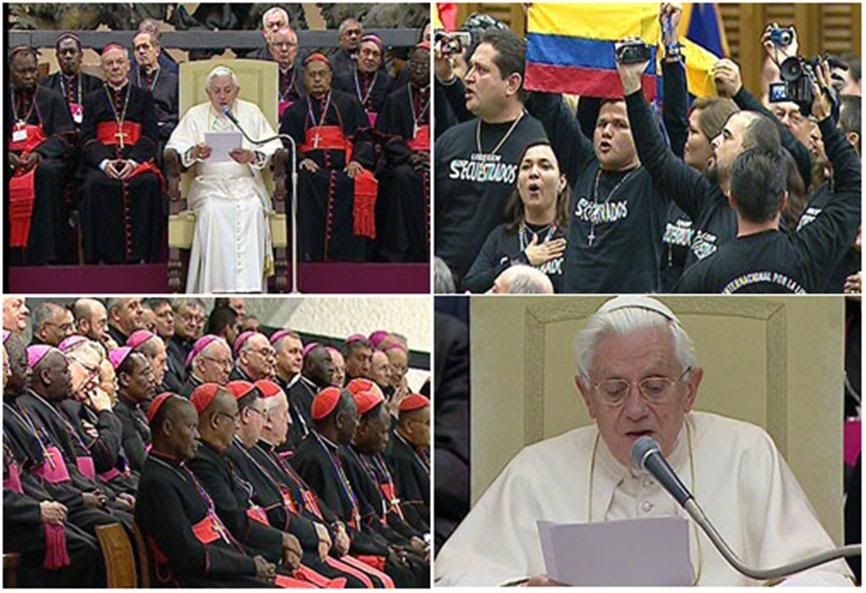
The great medieval cathedrals
and the 'way of beauty' towards God
Dear brothers and sisters:
In the catecheses of the past few weeks, I have presented some aspects of medieval theology.
But the Christian faith, profoundly rooted in the men and women of those centuries, did not give rise only to masterpieces of theological literature, of the thinking of the faith.
It also inspired some of the most elevated artistic creations in universal civilization: the cathedrals, the true glory of the Christian Middle Ages.
Indeed, for almost three centuries, from the start of the 11th century, Europe experienced an extraordinary artistic fervor. A chronicler describes the enthusiasm and industry at that time: "In all the world, especially in Italy and the Gallie [???], they are starting to rebuild the churches, even if many, which are still in good condition, do not need restoration. It is like a race between one place and the other. One would think that the world, shaking off its old rags, wishes to clothe itself anew with the white robes of new churches. In short, almost all the cathedral churches, a great number of monastic churches, and even village oratories, are being restored by the faithful" (Rodolfo il Glabro, Historiarum 3,4).
Various factors contributed to this rebirth of religious architecture. Above all, more favorable historical conditions, like better political security, accompanied by a constant population growth and progressive development of cities, of exchange and of wealth.
Moreover, the architects were identifying increasingly specific technical solutions to enlarge the dimensions of the buildings, while assuring their stability and majesty.
But it was principally thanks to the ardor and spiritual zeal of monasticism in full expansion that abbatial churches were built where the liturgy could be celebrated with dignity and solemnity, and the faithful could stop to pray, attracted by the veneration of saints' relics, which was the goal of incessant pilgrimages.
Thus were born the Romanesque cathedrals and churches, characterized by longitudinal development, with long naves that could accommodate numerous faithful. These were very solid churches, with thick walls of stone, built along simple and essential lines.
One novelty was the introduction of sculptures. Since the Romanesque churches were the place for monastic prayer and for worship by the faithful, sculptors were more concerned with educational ends [the catechetical value of their work] than with technical perfection.
Because it was necessary to arouse strong impressions, sentiments which could inspire the faithful to flee from vice and evil, and to practise the virtues instead, that which is good - a recurrent theme was the representation of Christ as the universal Judge, surrounded by figures from the Apocalypse.
Usually, it was the doors of the Romanesque churches that offered thsse depictions, to underscore that Christ is the Gate leadaing to Heaven.
The faithful, crossing the threshold of the sacred edifice, entered a time and space different from ordinary life. Beyond the church doors, the artists intended that believers in Christ - sovereign, just and merciful - might be able to have a foretaste of eternal beatitude in the celebration of the liturgy and other acts of piety performed within the sacred edifice.
In the 12th and 13th centuries, starting in northern France, another type of church architecture spread - the Gothic, with two new characteristics compared to the Romanesque, namely, verticality and luminosity.
Gothic cathedrals demonstrated a synthesis of faith and art harmoniously expressed through the universally fascinating language of beauty which even today inspires wonder.
Thanks to the introduction of the arched vault resting on robust pillars, it was possible to construct much higher buildings. This elevation was an invitation to prayer, and was in itself prayer. Thus did the Gothic cathedral translate, in its architectonic lines, the yearning of the soul towards God.
Moreover, with the technical solutions reached, windows could be set into the perimeter walls and decorated with polychrome glass. In other words, the windows became great luminous images which were very appropriate for instructing the people in the faith.
Those windows, scene by scene, narrated the life of a saint, a parable, Biblical events. The stained glass windows allowed streams of light within the church while narrating to the faithful the story of salvation and getting them involved in that story.
One other quality of the Gothic cathedrals was that the entire Christian and civilian community participated in their construction and adornment, in different ways but together. The humble and the powerful, the illiterate and the educated, participated together so that in this common home, all believers could be instructed in the faith.
Gothic sculpture made these cathedrals into Bibles of stone, representing the episodes of the Gospel and illustrating the content of the liturgical year, from the Nativity to the Glorification of the Lord.
In those centuries, moreover, the perception of the humanity of the Lord was gaining ground, and the sufferings of his Passion came to be represented in a realistic manner: the Suffering Christ (Christus patiens) became an image beloved by all, appropriate for inspiring piety and repentance for one's sins.
Nor were personages from the Old Testament missing - their stories became very familiar to the faithful who attended these cathedrals as a part of the singular and common story of salvation.
With their faces full of beauty, tenderness and intelligence, Gothic sculpture revealed a happy serene faith, which took special pleasure in establishing a heartfelt filial devotion to the Mother of God, sometimes seen as a young woman, smiling and maternal, but mainly depicted as Queen of heaven and earth, powerful and merciful.
The faithful who flocked to the Gothic cathedrals also enjoyed finding artistic expressions that recalled the saints, models of Christian life and intercessors with God.
Nor was there a lack of the 'secular' aspects of existence. Thus there came to be depictions of work in the fields, of the sciences and the arts.
Everything was oriented and offered to God in the place where liturgy was celebrated.
We can better understand the meaning that was attributed to the Gothic cathedral, by considering the text of the inscription carved on the central portal of St. Denis in Paris: "Passerby, who may wish to praise the beauty of this doors, do not be blinded by gold, nor by magnificence, but rather by effortful work. Here shines a famous work, but Heaven grant that this brilliant work may make spirits shine forth, so that with luminous truth, they can walk towards the true light, to which Christ is the true door".
Dear brothers and sisters, I would like now to underscore two elements of Romanesque and Gothic art that are useful even for us.
The first: the artistic masterpieces both in Europe in past centuries are incomprehensible if one does not consider the religious spirit that inspired them.
An artist, who has always testified to the encounter of aesthetics and faith, Marc Chagall, wrote that "painters for centuries have dipped their brushes into the multicolored alphabet that is the Bible".
When faith, celebrated specially in liturgy, encounters art, a profound syntony is created, because both can and wish to speak of God, making visible the Invisible.
I wish to share this in my meeting with artists on November 21, renewing to them the offer of friendship between Christian spirituality and [contemporary] art that was hoped for by my venerated predecessors, particularly the Servants of God Paul VI and John Paul II.
The second element: the power of the Romanesque style and the splendor of Gothic cathedrals remind us that the via pulchritudine, the way of beauty, is a privileged and fascinating way to get closer to the mystery of God.
What is the beauty that writers, poets, musicians, and artists contemplate and translate into their language other than the reflection of the splendor of the eternal Word made flesh?
St. Augustine says: "Ask the beauty of the earth, ask the beauty of the sea, ask the beauty of the air. Ask the beauty of heaven, ask the order of the stars. Ask the sun, which lights up the day with its splendor. Ask the moon, whose diffuse light softens the shadows of the night. Ask the beasts that swim in water, that walk on the earth, that fly in the air: souls that are hidden, bodies which are seen; the visible that need to be led, the invisible who lead. Ask them! And all will answer: Look at us, we are beautiful! Their beauty makes itself known. And this mutable beauty - who has created it if not Immutable Beauty?" (Discorsi, 241, 2-3).
Dear brothers and sisters, may the Lord help us to rediscover the way of beauty as one of the itineraries - perhaps the most attractive and fascinating - in order to reach, meet and love God.
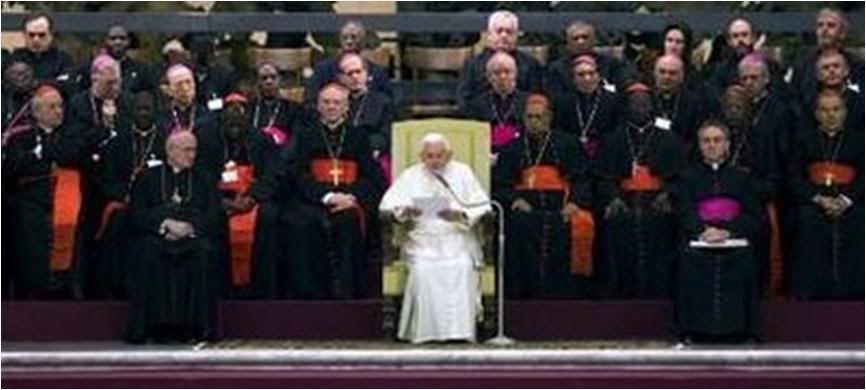
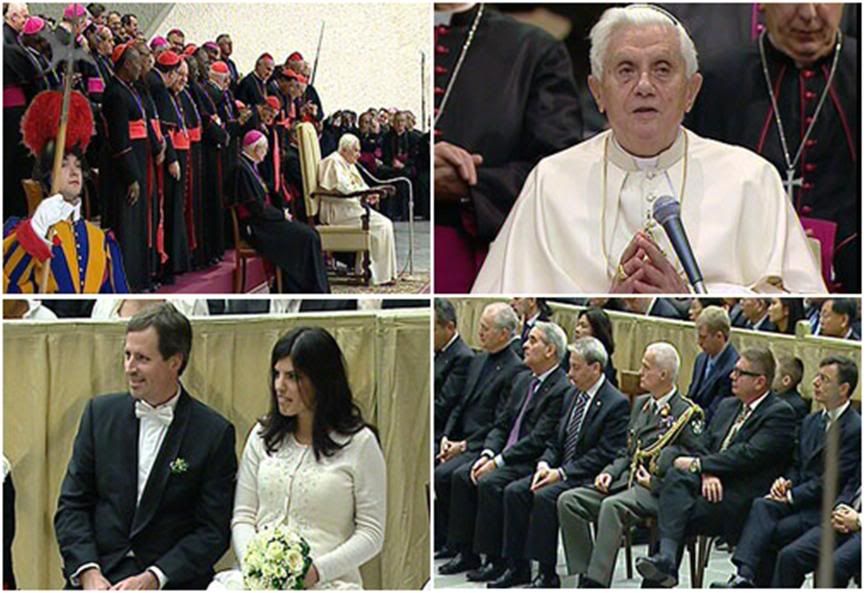
In his greetings to various language groups, the Holy Father recalled the feast today of the Dedication of St. Peter's and St. Paul's basilicas in Rome, to Polish pilgrims and to the Italians, and recalled to Slovakians the recent 20th anniversary of their liberation from the yoke of Communism. In Italian, he said:
I am particularly pleased to welcome the cardinals, bishops and all the members of the Plenary Assembly of the Congregation for the Evangelization of Peoples, presided by Cardinal Ivan Dias.
Your presence gives me the opportunity to renew to each of you my gratitude for the generous commitment with which you work in order to spread the Gospel message.
I entrust your plenary meeting to the Most Blessed Mary, Queen of Apostles, invoking her maternal assistance on all who are engaged in missionary activity in every corner of the earth.
I greet the representatives of the Italian Federation Addetti al Culto ['assistants for worship'] and I express my pleasure for the work they carry out in the preparation and care of liturgical spaces as well as the cultural assets in the custody of the Church.
In today's liturgy, we celebrate the dedication of St. Peter's basilica in the Vatican and that of St. Paul on the Via Ostiense. This feast offers us the opportunity to highlight the meaning and the value of the Church.
Dear young people, love the Church and cooperate with enthusiasm in its edification. Dear patients, offer your suffering as a precious contribution to the spiritual growth of the Christian community. And dear newlyweds, be in the world a living sign of Christ's love.
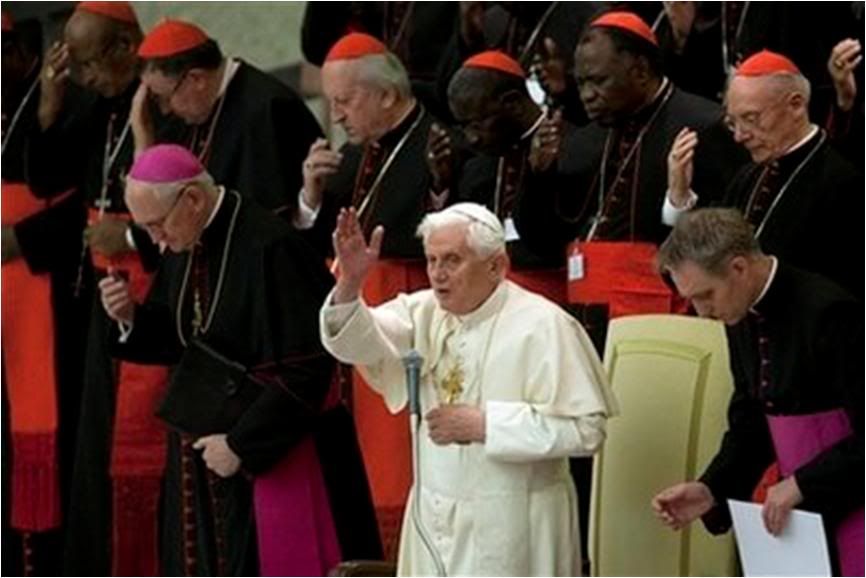
[Modificato da TERESA BENEDETTA 18/11/2009 17:11]